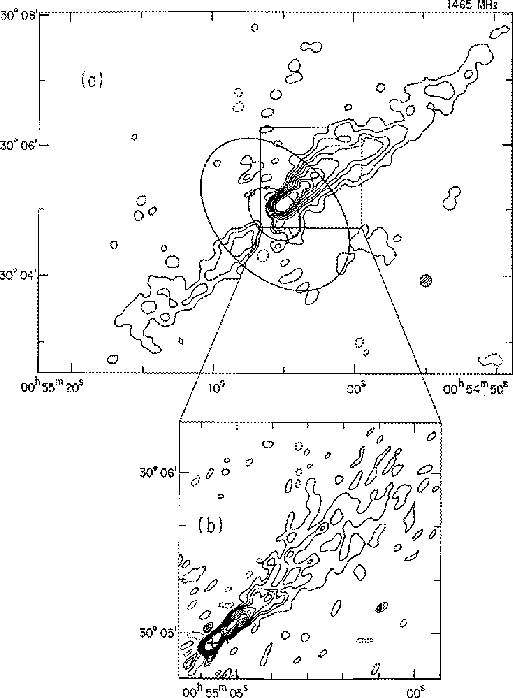
On 23 June 1978, Ed Fomalont, Mike Davis, and I were given time to observe the radio galaxy NGC315 with the "sub-VLA" -- a dozen antennas on 10.5 km of the West arm and 1.5 km of the East arm. NGC315 is one of the "giant", i.e., Mpc-scale, radio galaxies, covering almost a degree on the sky (Bridle et al. 1976). We had previously used the Green Bank Interferometer to show that the radio source contained a narrow, kiloparsec-scale feature next to an unresolved component in the nucleus of the elliptical galaxy. The narrow feature was aligned with a bridge of emission linking the galaxy to one lobe of the giant structure, so we thought that it might be the innermost part of an exceptionally long "radio jet". Although the largest-scale structures would be resolved out, we hoped that a long synthesis would allow us to image the narrow feature in some detail because most of its flux density could be captured whenever the short-baseline fringes aligned with it.
We were not disappointed. We got good data from most of the antennas at 4885 MHz and 1465 MHz. The bases of the jet and of a counterjet were not only detected, but also transverse-resolved. We could therefore measure the jet's opening angle, or spreading rate, as a function of distance from the nucleus. We also saw that to make full use of the data we needed to deconvolve the sub-VLA's sidelobe pattern from a large area of sky by 1978 standards -- fully 256 × 256 pixels! We needed to make a 512 × 512 dirty image and beam to do this using the Högbom (1974) CLEAN algorithm. This was a non-trivial computation in 1978, because the CLNMAP program had to be run in the same heavily-loaded DEC-10 that handled most of the off-line computing at the VLA site. Only 128 × 128 CLEANs could be submitted to the DEC-10 routinely, so we needed Barry Clark's permission to run ours.
At this early stage of VLA work, deconvolution did not have the central role in image processing that it has today. CLEAN was still seen as a temporary stop-gap, a processing step that might not be needed when the VLA was completed. (The VLA had been designed to give sidelobe levels low enough that its "dirty" images could be used directly for science.) Despite the nuisance value of our request, Barry let us run an "over-sized" CLEAN on NGC315 on a weekend when the DEC-10 was lightly loaded.
| Figure 1: The upper panel shows the 1465 MHz contour plot of NGC 315 at 11" resolution; an unresolved nuclear source was subtracted. The ellipses show the size and orientation of the overexposed core and outer envelope of the galaxy on the red-sensitive National Geographic Society -- Palomar Observatory Sky Survey print. The inset shows the VLA data at 2.5" resolution. (From Bridle et al. 1979.) |
Our 1465-MHz data traced the jet and counterjet for a few tens of kiloparsecs away from the nucleus (see Figure 1). The key result was that the structure of these jets changes with distance from the nucleus in several ways. The jet ridge lines "wiggle", the brighter jet clearly spreads at a variable rate, and its degree of linear polarization increases outwards. This was evidence for ongoing changes in the jets' collimation and internal structures, including the magnetic field configuration, on scales that were easily resolvable by the VLA. VLA observations of such jets might therefore be able to provide important clues to the physics of jet propagation on kiloparsec (and greater) scales in galactic environments.
The clientele for CLEANing "large" fields of view ballooned as more extended sources were studied with the sub-VLA. But the DEC-10 could not handle the growing demand for the Högbom CLEAN. Fortunately, Barry turned this computing problem into a wonderful opportunity, and gave us the "Clark CLEAN" (Clark 1980).
To move some of the deconvolution load out of the DEC-10, Barry coded a CLEAN for a PDP11/70 and FPS120B Array Processor that were later to become part of the spectral-line "pipeline" system. The FPS120B had three control panel lights: one for power, one showing data transfer activity, and one showing array processor activity -- actual computation. Barry says that watching these lights showed him that his first CLEAN code spent too little time doing the computations. Most of the time instead went into shuffling data in and out of the AP memory. The more efficient algorithm that he developed to keep the "AP activity" light lit up saved our bacon in the early 1980's. Without it, the practice of feeding CLEAN models back into self-calibration, which was the route to high image fidelity, would have been slow to develop. Barry's efficient AP microcode later went around the world as part of AIPS, and the "computation" light stayed lit up on the AP's of thankful VLA users for years thereafter.
Our early look at NGC315 with the sub-VLA previewed some features of FRI jets which may still be central to understanding differences between jet propagation in FRI and FRII sources; but it may have advanced the field more by being one of the early projects that got Barry Clark thinking about an efficient CLEAN algorithm.
| Figure 2: A modern VLA image of NGC315 at 2" resolution superposed on an image of the galaxy from the Digitized National Geographic Society -- Palomar Observatory Sky Survey. |
Figure 2 shows the radio jets and the galaxy in modern dress, superposing a 4885 MHz VLA multi-configuration image of the radio jets on the red-sensitive image of NGC315 from the Digitized National Geographic Society -- Palomar Observatory Sky Survey.
Alan Bridle
Tue Oct 13 15:58:42 EDT 1998